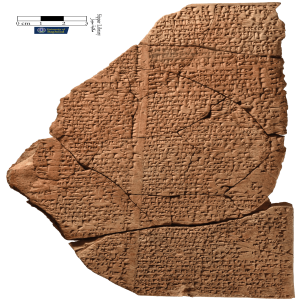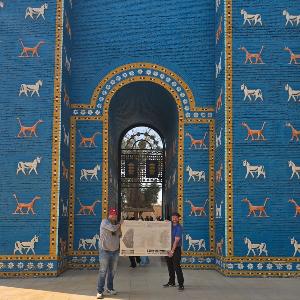Hymn to Babylon discovered
1 Jul 2025
The previously unknown hymn of praise comes from the period around 1000 BCE. LMU Professor Enrique Jiménez used AI to find 30 other related manuscripts.
1 Jul 2025
The previously unknown hymn of praise comes from the period around 1000 BCE. LMU Professor Enrique Jiménez used AI to find 30 other related manuscripts.

© Anmar A. Fadhil, Department of Archaeology, University of Baghdad. With the permission of the Iraqi Museum and the State Board of Antiquities and Heritage
In the course of a collaboration with the University of Baghdad, LMU’s Enrique Jiménez has rediscovered a text that had been lost for a thousand years. “It’s a fascinating hymn that describes Babylon in all its majesty and gives insights into the lives of its inhabitants, male and female.”
Babylon was founded in Mesopotamia around 2000 BCE. Once the largest city in the world, it was a cultural metropolis in which works were written that form part of our global literary heritage today.
Babylonian texts were composed in cuneiform writing on clay tablets, which have survived only in fragments. One of the goals of the collaboration with the University of Baghdad is to decipher hundreds of cuneiform tablets from the famous Sippar Library and preserve them for posterity. Legend has it that Noah hid them here from the floodwaters before boarding the ark.
In the „Electronic Babylonian Library Platform“ Enrique Jiménez is digitizing all cuneiform text fragments that have been discovered worldwide to date and using artificial intelligence to decipher fragments that belong together. “Using our AI-supported platform, we managed to identify 30 other manuscripts that belong to the rediscovered hymn – a process that would formerly have taken decades,” says Jiménez, Professor of Ancient Near Eastern Literatures at LMU’s Institute of Assyriology. Thanks to these additional texts, the scholars were able to completely decipher the hymn of praise on the clay tablet, parts of which were missing.
The hymn was copied by children at school. It’s unusual that such a popular text in its day was unknown to us before now.Enrique Jiménez , Professor of Ancient Near Eastern Literatures at LMU’s Institute of Assyriology

Es markiert den Eingang zur archäologischen Stätte Babylons. Sie halten eine Tafel mit Auszügen des entdeckten Textes. | © Junko Taniguchi
These numerous additional copies suggest that the text was very widespread at the time. “The hymn was copied by children at school. It’s unusual that such a popular text in its day was unknown to us before now.” The paean presumably comes from the start of the first millennium before Christ and comprises 250 lines.
“It was written by a Babylonian who wanted to praise his city. The author describes the buildings in the city, but also how the waters of the Euphrates bring the spring and green the fields. This is all the more spectacular as surviving Mesopotamian literature is sparing in its descriptions of natural phenomena,” observes Enrique Jiménez.
The information about the women of Babylon, their role as priestesses and the associated tasks, has also astonished experts, as no texts describing these things were previously known. In addition, the hymns provide insights into coexistence in urban society. For example, the inhabitants are described as being respectful to foreigners.
The following lines are from the newly discovered hymn. They describe the river Euphrates, on whose shore Babylon lay at that time:
The Euphrates is her river – established by wise lord Nudimmud –
It quenches the lea, saturates the canebrake,
Disgorges its waters into lagoon and sea,
Its fields burgeon with herbs and flowers,
Its meadows, in brilliant bloom, sprout barley,
From which, gathered, sheaves are stacked,
Herds and flocks lie on verdant pastures,
Wealth and splendor – what befit mankind –
Are bestowed, multiplied, and regally granted.
Translation: „electronic Babylonian Library“
Anmar A. Fadhil und Enrique Jiménez: Literary texts from the Sippar Library V: A hmyn in praise of Babylon and the Babylonians. Doi:10.1017/irq.2024.23 In: IRAQ 2025, Cambridge University Press.
Electronic Babylonian Library: Playing with the source of world literature